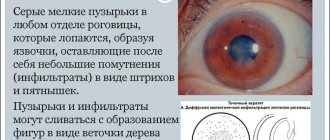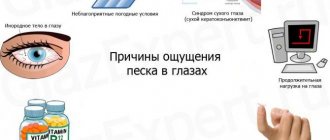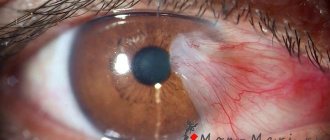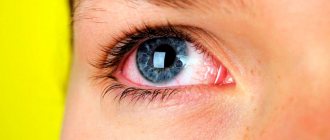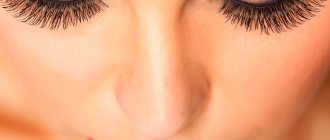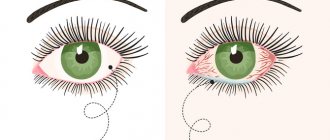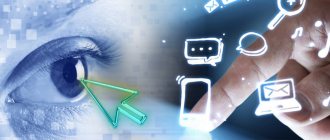- June 25, 2018
- Ophthalmology
- Vasily Shushakov
Our modern life is full of stressful situations. And how can they be avoided if you need to be on time for everything and everywhere?! In addition, most people spend a lot of time at the computer (and it is sometimes very difficult without it today), which inevitably leads to fatigue, dizziness and other ailments. How can your eyeballs and head not hurt under such conditions?
The main thing here is to be alert, because prolonged pain, which puts pressure not only on the head, but also on the organs of vision, can subsequently cause the development of serious diseases. For this reason, it is necessary to promptly diagnose and begin a course of treatment.
A little anatomy
It can be said without exaggeration that our eyes are a valuable gift from God, which each of us should not only appreciate, but also cherish. Let's delve a little into the anatomy of the organ of vision. The eyeballs are characterized by an irregular spherical shape measuring within 24 mm.
Our eyes have three main components:
- Cornea, or cornea. Provides protection to the inside of the eyeball from external factors.
- Lens. It is a transparent body that is located inside the eye and is capable of reacting to light. This is a kind of biological lens - the most important apparatus for refracting light waves. If you do not take care of it, eye disease such as cataracts simply cannot be avoided. However, this applies to any part of the eyeball.
- Vitreous body. The consistency of this substance resembles a gel that fills the space between the lens and retina. It has the ability to focus light onto the inner shell with cones and rods.
The information perceived by the retina is transmitted through the optic nerve to the brain, where it is processed. There are many nerve endings in the eyes, and thus the organs of vision are directly connected to the central nervous system. It is precisely because of this that headache appears against the background of ocular discomfort. In this case, the pain may intensify with movement of the eyeballs.
Dangerous ophthalmopathologies
As soon as possible, you need to contact an ophthalmologist in a specialized medical institution for the following conditions and symptoms:
- Penetrating injury to the eyeball
- Thermal or chemical burn to the eye
- Ultraviolet radiation burn
- Contusion resulting from a blow from a fist or large object
- Corneal ulcer with perforation
- Foreign body entry
- Superficial damage with scratches on the cornea or conjunctiva
- Hematomas of the eyelids
- Acute inflammation
- Acute optic nerve disease
- Uveitis – inflammation of the choroid
- Acute attack of glaucoma
- The occurrence of sharp or dull pain
- Sudden blurred vision, fog before the eyes, partial loss of visual fields, double vision
- Severe redness, hemorrhage in the conjunctiva, eyelid skin, bleeding
- Excessive lacrimation
- Photophobia
The severity of the lesion does not always correlate with the intensity of pain and other traumatic manifestations.
It is difficult for a non-specialist to determine the degree of risk. Therefore, even with, at first glance, not a very serious injury, it is important to urgently go to an eye traumatology department.
What could be the reason?
There is not a person on the planet who would not encounter a headache, sooner or later, but it will overtake everyone. At this moment, you can experience a variety of emotions, which makes you feel nervous once again: what if the reason is quite serious? Life immediately becomes joyless when your eyeballs and head begin to hurt severely.
Why does this happen? Eye pain and headaches are closely related, and there can be quite a few reasons for their occurrence, and not everything is always as obvious as it seems at first glance. In this case, provoking factors can be divided into two large groups:
- Physiological.
- Psychological.
To understand what exactly was the reason for the appearance of such painful discomfort in relation to the head and eyes, it is necessary to carry out an analysis in each specific situation. Let’s first look at the physiological causes of pain, and then we’ll touch on psychological factors.
Diagnosis of injury
Diagnosis of the patient’s condition consists of several stages:
- If the patient can speak, anamnesis is taken from him. Find out what exactly was the damaging factor.
- Instillation of lidocaine solution into the damaged area. This is a local anesthetic that will stop the spasm of the eyelids. The doctor will be able to look at the patient's eyes.
- General examination of damaged tissues. The doctor detects inflammation of the mucous membrane, redness, penetrating wounds, and cloudiness. Based on these data, the ophthalmologist can suggest a diagnosis and prescribe further examination.
- Fundus examination. First, a solution is instilled onto the patient’s mucous membrane, which temporarily disrupts the process of pupil accommodation. The doctor identifies the condition of the vitreous body, cornea, lens, eye chambers, and retina.
- X-ray. The technique is necessary for penetrating wounds to find out how deep the foreign body has entered.
Based on the data obtained, the doctor can make a reliable diagnosis. Only after this is treatment carried out.
The scourge of modern man
Working on a computer is the most common activity among a large number of people. In this regard, pain in the eyes when moving the eyeball is not such a rare phenomenon. Every third (if not second) family can afford to purchase such equipment. Getting carried away by some activity or simply surfing the Internet, we, without noticing it, stop blinking. This is very harmful for the eyeball, because in this case it dries out, and this causes pain.
Sometimes you can feel as if sand has been poured into your eyes. When you lower your eyelids to give your eyes a little rest, you may feel pain, burning and tingling. And if this is repeated day after day, then your head starts to hurt. Often in the future this leads to inflammation of the eyelids against the background of decreased vision. To get rid of discomfort, you should alternate work with rest.
You are allowed to look at the monitor screen for no more than 40 minutes, and then be sure to take a break (10-15 minutes is enough), otherwise pain in the eyes cannot be avoided when the eyeball moves. While resting, you can simply close your eyelids or blink frequently. It is advisable to find a green tint in your surroundings, which is not so difficult to do - this color is calming.
Eye burn: what first aid should be
Burns appear from exposure to thermal, chemical and thermochemical factors. As part of providing first aid for eye burns, the doctor also has to deal with eye damage from ultraviolet radiation.
Electroophthalmia is the reaction of the visual organ to ultraviolet radiation. It appears when participating in electric welding work without eye protection. A similar reaction can occur under the influence of solar ultraviolet radiation, which is reflected from the snow surface.
With burns, there are complaints of severe photophobia along with a feeling of sand and severe stabbing pain in the eyes is likely. Dacryagogue is objectively determined along with spastic contraction of the eyelids and conjunctival hyperemia. As part of first aid, drops are instilled with a solution of "Dicaine", "Novocaine" or "Lidocaine", cold lotions will not interfere, along with placing the victim in a dark room.
Thermal burn of the eyelids is usually combined with damage to the face. The degree of such a burn is determined according to the same rules as on other surfaces of the body. As part of the assistance, analgesics are used orally and parenterally. The burned surface is treated with an alcohol solution of brilliant green. In case of an isolated burn of the eyelids, the victim should be taken to an eye hospital. When eyelid burns are combined with other injuries to other surfaces, a person needs a special hospital.
Thermal burns of the eyeballs are a consequence of hot neutral liquid or molten substance getting behind the eyelids. Eye burns due to hot air or steam are possible. In this case, there are complaints of severe pain in the eye along with photophobia and deterioration of vision up to its absolute loss. A pronounced clouding of the cornea is objectively determined. In this case, the use of analgesics is necessary. A solution of “Dicaine”, “Novocaine” or “Lidocaine” is instilled behind the eyelids, and “Albucid” and “Levomycetin” are also suitable. With such damage, the patient requires urgent delivery to an eye hospital.
Chemical burns occur from exposure to acids and alkalis. Usually such injuries are combined with facial injuries. The degree of eyelid burns is determined according to the same rules as on other surfaces of the body. In this case, the use of analgesics parenterally and orally is required. Treatment of a surface that has been burned with acid is carried out with a loose cotton swab dipped in soda. The surface burned with alkali is treated with boric acid. If an isolated burn of the eyelids occurs, the victim is taken to an eye hospital. And when combined with injuries to other surfaces, go to a burn hospital.
Pressure
We are talking about intracranial and intraocular pressure. When intracranial pressure increases, a headache often begins, and especially in the morning. The amount of cerebrospinal fluid increases, which leads to stretching of the arachnoid membrane of the brain. Because of this, in turn, pain appears. Moreover, in some cases it can be so strong that it radiates into the eyes - at this moment, it seems as if something is pressing on them from the inside.
The same can happen if intraocular pressure increases. And this is usually caused by glaucoma, inflammation or a cold. It is impossible to determine what kind of disease it is. Eyeballs and head hurt. What to do? Only a doctor can tell you this. And for this it is worth visiting the hospital.
And if the activity of symptoms can be reduced with the help of a light warming massage, then to completely get rid of the disease, an appropriate course of treatment is necessary. And here you simply cannot do without medical help.
Treatment with folk remedies
Immediately after discovering symptoms of inflammation of the upper or lower eyelid, the patient should immediately consult an ophthalmologist. He will conduct a comprehensive examination, if necessary, take samples of discharge from ulcers or samples of scales, and then offer an adequate treatment option.
Currently, depending on the severity of the disease, this may include local therapy, surgical treatment, or treatment of blepharitis at home. They need to be discussed in more detail.
Medication
This type of treatment involves three directions of influence:
- Local therapy - drops, antibacterial and antiseptic ointments.
- General, aimed at eliminating the cause: allergies, infections, general diseases. May involve taking broad-spectrum antibiotics, antiallergic drugs, antiviral complexes.
- Strengthening the body. This direction involves taking vitamins and restorative medications. It can be used both as part of general practice and as an independent type of treatment (if the disease was noted against the background of decreased immunity).
You should remember the dangers of self-medication for any disease, including blepharitis. The use of unconventional methods can only be carried out with the permission of the attending physician. Before use, it is also important to make sure that there is no hypersensitivity or allergy to any of the components of the products.
Traditional methods of treatment:
- Black tea. The strongly brewed drink is ideal for washing the eyes and eyelids. It is recommended to use natural long tea (not in bags). Tea compresses should be made immediately after brewing, since when left at room temperature for a long time, the plant begins to produce toxic substances. It is recommended to repeat the procedures 3-5 times daily.
- Camomile tea. It is advisable to use this remedy for the infectious form of blepharitis, since the plant has antibacterial properties. It is necessary to pour 1 spoon of dried flowers with a glass of boiling water. The resulting liquid should be used warm to wash the inflamed eyelids and eye membranes. The procedures should be repeated several times a day.
- Clover juice. To treat blepharitis, you can use only freshly squeezed liquid. In view of this, this method can only be used in the warm season. To prepare, you need to collect the required number of clover flowers and squeeze them out using gauze. The resulting liquid should be used to rinse the inflamed eyelids for 24 hours.
- Oak bark. A decoction made from this plant component is characterized by a pronounced antibacterial and anti-inflammatory effect, and therefore is excellent for blepharitis. To prepare the product, you need to mix 3 tablespoons of crushed bark and 250 ml of water. The liquid must be heated in a water bath for about 25 minutes, then squeezed out and water added so that 300 ml of the finished medicine is obtained. The decoction should be washed regularly with the eyelids, avoiding contact with the eyes.
- Cottage cheese. It is believed that fermented milk product has a positive effect on the condition of inflamed tissues, accelerating the process of eliminating toxins and pathogenic microorganisms. For blepharitis, it is recommended to use it as a compress on the affected eyelids. Fresh whey can be used in the same way.
Undoubtedly, there are many useful remedies for blepharitis, but it is recommended to be treated with traditional methods, which are more effective and safer for the body.
While watching the video you will learn about the treatment of stye.
Blepharitis is an inflammatory disease that affects the eyelids and is accompanied by many unpleasant symptoms. For successful treatment of the disease, it is extremely important to determine the exact cause of the inflammation, after which appropriate medications are prescribed.
In order to get rid of the disease as soon as possible, therapy must be comprehensive.
Doctors advise adhering to some principles that will make the treatment effective:
- You should refrain from scratching sore eyes.
- It is necessary to reduce watching TV shows and staying near the computer to a minimum.
- To strengthen the immune system, it is recommended to review your nutritional diet, including more healthy foods.
Regardless of the type of inflammatory disease, first of all, you will need antiseptic agents to wash the affected visual organs.
If the eyelid is inflamed, it would be appropriate to use:
- Alomida;
- Dexamethasone;
- Lecrolina;
- Maxitrol.
Instead of drugs with antiseptic properties, you can use tea, and also brew chamomile, cornflower or calendula.
The treatment course is drawn up taking into account provoking factors. If the inflammatory process was caused by smoke, dust or bright lighting, the symptoms may disappear without outside intervention once the cause is eliminated.
When the cause of inflammation is a bacterial infection, products containing antibiotic substances are selected.
Treatment is often carried out:
- Oxacillin, Biseptol (for internal use);
- Hydrocortisone, Prednisolone, Sulfacyl sodium (eye drops);
- tetracycline, furacilin, gentamicin ointments.
In the presence of non-purulent inflammation, only local drugs are prescribed.
Among the pathologies that cause inflammation of the upper eyelid, blepharitis of an allergic or bacterial nature is quite common. When it develops, treatment is usually lengthy and complex.
It will be possible to cope with an unpleasant disease only through an integrated approach.
In other words, the therapy is applied:
- local;
- etiological;
- restorative.
Drugs to eliminate blepharitis are selected depending on its type. If the scaly type is present, 4-5 times treatment with tetracycline or albucid ointment is indicated after preliminary washing of the eyelids.
If there is an ulcerative form, the dried crusts are first removed, after which the ulcers are lubricated with brilliant green. The eyes are instilled with any drops with disinfecting properties.
Etiological therapy is aimed at combating the factor that caused the disorder:
- Staphylococcal infections are fought with antibiotics;
- antihelminthic drugs are prescribed to patients whose blepharitis was caused by helminthic parasites;
- a disease of fungal origin is treated with medications with antifungal action;
- To get rid of allergic inflammation, you first need to identify the allergen and prevent its further exposure, after which you will need to take antihistamines.
In case of weakened immunity, the doctor prescribes medications that will support the body's defenses.
Before starting treatment, it is worth determining why the eyelids become inflamed and itchy. Only an ophthalmologist can establish an accurate diagnosis, and you should contact him at the first signs of discomfort.
Itching and inflammation are caused by many reasons, for example:
- getting dust or animal hair into your eyes;
- barley, abscess;
- use of low-quality cosmetics;
- conjunctivitis, cataracts;
- weakening of the immune system;
- insect bites.
Most common reason
Hypertension affects most of the world's population. At first, the risk group included mainly elderly people, but today this disease also occurs among young people. Thus, according to statistics, among the registered cases diagnosed with hypertension, every second patient is under 50 years of age.
When pressure increases, the load on the walls of blood vessels sharply increases, which, in fact, causes headaches. It may be accompanied by nausea, dizziness, tinnitus, and black spots may flash before the eyes. If the upper threshold exceeds 150, the pain is radiated not only to the eyes, but also to the neck.
As many people note, headaches and eyeballs often hurt in the heat. You can relieve discomfort and lower blood pressure by massaging your forehead, temples, neck and area behind the ears. The best way to prevent this disease is to follow a daily routine.
Preventive measures
If you follow certain rules, you can prevent the onset of the disease. The most important among them:
- hand cleanliness;
- try once again not to pry into your eyes unnecessarily;
- keep your eyes clean (in the morning and evening you need to thoroughly rinse your eyes to remove accumulated unnecessary foreign bodies);
- the use of eye drops for asepsis is recommended;
- having your own towel and cosmetics;
- reducing stress on the visual organs.
If a person often experiences this disease, then you need to:
- careful lens care;
- active and healthy lifestyle;
- treatment of chronic sites of infection;
- rest in sanatoriums and resorts;
- taking immune medications (prescribed by your doctor).
Follow all the rules of personal hygiene, watch your diet, get plenty of rest, and then the disease will definitely not arise again.
Viral diseases
Ailments such as ARVI and influenza can also contribute to the appearance of pain not only in the head, but also in the eyes. In this case, it is usually accompanied by a runny nose and sore throat. Also, body temperature always rises. Eye pain during a cold is caused by the fact that the inflamed areas put pressure on the eyeballs.
Why do my eyeballs and head hurt? Another disease that causes symptoms is meningitis. Inflammation of the lining of the brain is also caused by an infectious agent. With this illness, the patient suffers from severe headaches that radiate to the eyes. The disease manifests itself as an increase in body temperature accompanied by vomiting, which is not associated with food intake. Visual impairment and seizures are also noted.
First symptoms
Symptoms of conjunctivitis include:
- itching, discomfort, burning in the eye area;
- hyperemia of the conjunctiva, the formation of bubbles on it;
- lacrimation;
- discharge - mucous, purulent or in the form of films;
- sticking of eyelids after sleep;
- pain in the eyes, their fatigue;
- swelling, redness of the eyelids;
- photophobia;
- sensation of a foreign body;
- dry eyes, cracks in the corners;
- blepharospasm.
What does pain in the forehead mean?
Not only eye diseases are to blame for the fact that most people suffer from severe headaches (about 60%), the symptoms may be due to the development of pathology in the blood vessels of the brain. These include pallor, weakened general condition, attacks of nausea and vomiting. If the disease is viral in nature, then treatment should be carried out in combination. Otherwise, excessive use of antibiotics will lead to increased pain.
If pain is felt in the right side of the forehead, then this usually indicates the following cases:
- Osteochondrosis of the cervical spine.
- Development of stroke.
- The presence of neoplasms in the body.
- Getting injured.
- Costen's syndrome.
- Tonsillitis.
- Paroxysmal hemicrania of chronic form.
What can cause pain in the eyeballs and head on the left side of the forehead?
In this case, everything may indicate diseases that are widespread in many countries of the world:
- The appearance of tumors.
- Osteochondrosis.
- Diseases of an infectious nature.
- Migraine.
- Cold.
- Uneven distribution of muscle load.
- Sustaining head and neck injuries.
- Stroke.
- Meteosensitivity.
Displaced cervical vertebrae can cause pain, caused by incorrect posture or exposure to too much stress.
Injuries to the organs of vision, what to do?
Prevention of school injuries.
Injuries to the organs of vision, what to do? School injuries are injuries to students of various age groups in the school environment. These are the injuries that can occur in any lesson: in physics, chemistry, physical education, technology lessons, etc.
The concept of “trauma” (Greek trauma - damage, injury) includes a violation of the anatomical integrity or physiological functions of human tissues or organs caused by a sudden external influence.
Prevention of school injuries is a set of measures aimed at preventing and eliminating risk factors in the school environment.
Prevention (Greek prophylaktikos - protective) - various measures to prevent and/or eliminate any phenomenon or risk factor for human life and health. This term is widely used in many fields of science and technology. In the healthcare system, prevention and preventive measures are the formation of medical and social activity among the population and motivation for a healthy lifestyle.
During school activities, at home, on the street, when attending any events, during the holidays, on trips, travel, etc. young people are prone to underestimating danger, increased risk, rash actions, as well as deliberate violation of safety rules, which manifests itself in children and adolescents in order to achieve a goal with the least expenditure of effort and energy to complete the assigned work faster. Children's confidence that nothing will happen leads to a disdainful attitude towards danger.
Eye injuries are a very common occurrence and most often occur due to negligence or violation of safety rules. Such injuries can occur under any conditions and circumstances. To prevent this from happening, it is necessary to follow safety rules in the classroom, at home, and in other life situations, remember what teachers and parents advise, and be able to act correctly.
So, an eye injury is any damage to the organ of vision. Eye injuries are divided into mechanical (injury to the eyelids or the eyeball itself, impact, etc.) and chemical (ingress of alkalis, acids and other solutions).
Eyes are very important organs of the human body, because thanks to them we are able to see. They are practically not protected by anything and often external factors have a negative impact, which can even lead to blindness. The eyes are very sensitive, so they require careful care, and the slightest damage to them is accompanied by very painful sensations. Most often, when injured, the cornea, lens, and vitreous body are damaged, and the retina and optic nerve can also be injured.
Types of visual injury:
- Contusions of the eyeball are bruises that occur as a result of direct or indirect impact on the eyes.
- Superficial damage (common eye injury) is non-penetrating wounds, ingress of foreign bodies.
- Penetrating wounds of the eyeball are injuries that are accompanied by severe complications. Such injuries can lead to vision loss.
- Eye burns – chemical, thermal, radiation exposure. A chemical burn to the eyes can be the result of exposure to various acids, alkalis, household chemicals, and cosmetics. Thermal burns occur when the eye is exposed to high temperatures.
- Penetrating foreign bodies are a mechanical effect on the structure of the eye. This may include gunshot wounds to the eyes.
An eye injury occurred. What to do, where to turn for help? It is imperative to know the procedure for dealing with such injuries, as this can save your eyesight.
Procedure for providing assistance for eye injuries and what not to do
Actions that are unacceptable in case of eye injuries:
- press or rub the injured eye;
- rinse the eye if there is a possibility of penetrating injury (exception: if chemical solutions get into the eye, rinse as quickly as possible with warm boiled water);
- under no circumstances should you touch or try to remove a foreign body that sticks out of the eye;
- You cannot use cotton wool or cotton swabs as a bandage, since in case of penetrating wounds, small fibers from the cotton wool can get into the eye (the exception is heavy bleeding);
- try to neutralize the effect of one harmful substance with some other, for example, in case of a burn with acid, try to rinse with an alkali solution;
- touch your eyes with unwashed hands.
So, if your eyes are burned, it is strictly forbidden to rub your eyes, apply drops of improvised means, or rinse with water.
First aid for eye injury
- For any type of eye injury, first aid should be provided immediately. Any manipulations with the victim’s eyes should be carried out only with clean hands; if possible, they should be treated with an antiseptic eye solution;
- in some cases it is recommended to instill antibacterial drops (albucid, chloramphenicol);
- if necessary, apply a bandage to both eyes, since the eyes are a paired organ, moving the healthy eye leads to movement of the damaged one, and this often aggravates the injury;
- in cases of bleeding, it should be stopped immediately using a sterile cotton swab and a clean gauze bandage applied;
- After providing first aid, you should go to the emergency room with a visual injury as soon as possible.
For eyelid injuries, burns and other injuries, the following must be done:
- Clean the damaged area as carefully as possible with water or an antiseptic eye solution;
- if possible, apply cold, but without any pressure on the eye, covering the wound with a clean bandage;
- if the bleeding is severe enough, you can make a bandage of cotton wool or gauze;
- See a doctor if you have an eye injury.
It is necessary to protect your eyesight and not forget about basic safety! Following basic safety measures will help avoid injury and preserve your vision.
Safety rules to prevent eye injury
- be sure to wear special glasses when performing certain types of work in which there is a possibility of foreign bodies getting into the eyes;
- work only in a well-lit room;
- carefully use household chemicals, and especially caustic substances and acids, since very often due to carelessness they get into the eyes;
- do not do heavy housework if you feel unwell, because in such cases attention decreases and the possibility of injuring your eyes increases;
- avoid frequent bright light, and especially ultraviolet radiation;
- be sure to wear special masks or goggles when carrying out welding work;
- Do not self-medicate under any circumstances, as this can only worsen the situation.
Children's headaches in the forehead area
Headaches among children are not such a rare phenomenon; this problem especially affects high school students. There may be several reasons for this:
- Stress. Strictly speaking, this refers to the psychological aspect: negative attitude, and sometimes even aggression from peers, classmates, separation from loved ones, change of environment (moving to a new place of residence).
- Infection of the body. It manifests itself as a high temperature, eyeballs and head hurt, there is a cough and a runny nose accompanied by nausea and vomiting.
- Hunger.
- General fatigue of the child's body.
- Changes in blood pressure.
In addition, it is worth considering that most children lead a more active lifestyle, which does not exclude the possibility of getting head injuries. And if after such an injury the child’s condition worsens, accompanied by vomiting, it is necessary to immediately visit a pediatrician. These symptoms may be due to a concussion or increased intracranial pressure.
Classification
Based on the nature of the course, conjunctivitis is distinguished:
- spicy;
- chronic.
Depending on the etiology, conjunctivitis is classified into:
- allergic;
- bacterial;
- angular - caused by Morax-Axenfeld diplobacillus;
- viral;
- fungal;
- chlamydial - caused by the bacterium chlamydia;
- epidemic - the provocateur is the Koch-Wicks wand.
- dystrophic - formed when the mucous membrane is damaged by substances (chemicals, gas).
Classification of the disease according to the condition of the conjunctiva:
- purulent - characterized by the release of pus;
- hemorrhagic - the presence of hemorrhages;
- catarrhal - discharge without pus;
- papillary - the formation of granular formations and compactions;
- membranous - discharge in the form of a film;
- follicular - the appearance of follicles.
Unfavorable factors
Against the backdrop of regular stressful situations, migraines cannot be avoided. This manifests itself in the form of a headache, which can be localized on one side of the head (right or left), in the eyeballs, or ears. However, sometimes these symptoms are accompanied by nausea.
Severe pain can simply throw a person off balance: it is impossible to work, do household chores, and so on. There are simply no drugs that can effectively and quickly stop attacks in nature. And the available painkillers, sold in many pharmacies, can only partially eliminate unpleasant symptoms. In this regard, it is necessary to try to protect yourself from exposure to factors that cause your eyeballs and head to hurt.
Acute attack of glaucoma
The development of such a dangerous disease as glaucoma is asymptomatic in most cases. Increased intraocular pressure can be detected during routine medical examinations, which should not be ignored. If glaucoma is not diagnosed promptly, it can lead to damage to the optic nerve. An acute attack of glaucoma has dangerous consequences and therefore requires emergency ophthalmological care. The attack develops rapidly, within a few minutes. Symptoms:
- swelling of the eyelids and conjunctiva;
- severe pain in the eyes, the pain radiates to the head, so it is often confused with migraine;
- rapid decline in vision;
- redness of the skin around the eyes;
- dilated pupil that does not respond well to light.
Emergency care for an acute attack includes pain relief, diuretics, combination medications that cause contraction of the ciliary muscle (widen the angle of the anterior chamber of the eye), and instillation of drops that reduce intraocular pressure. If conservative treatment methods are ineffective, the patient undergoes surgery to restore free circulation of intraocular fluid.
Consequences of neurosis
The result of strong nervous tension is the appearance of neurosis. This disease is characterized by a variety of symptoms. This includes fainting, nausea, and a feeling of wandering “goosebumps” on the surface of the skin. But the most important and sure sign is the appearance of a headache, which then radiates to the eyes and neck.
Because of this, the disease is nicknamed the “neurotic helmet” syndrome - a person feels as if he is wearing some kind of helmet or helmet that is squeezing his head. The chronic stage of neurosis poses a serious threat. Sometimes the constant pain caused hallucinations in some patients.
To get rid of neurosis, a course of psychotherapy is prescribed, which is a difficult and long period of recovery. On your own, you can alleviate the symptoms through traditional medicine. To do this, it is effective to take baths with aromatic oils. Tea with valerian and mint, meditation - all this is also beneficial.
Who should I turn to for help?
If your eyeballs and head hurt, which doctor should you consult? This question arises for almost everyone who begins to experience similar symptoms. It all depends on the characteristics of the manifestation of symptoms. The following doctors can provide medical assistance:
- Therapist.
- Neuropathologist.
- Psychotherapist.
- Reflexologist.
At the first visit to the therapist, the doctor will interview the patient in detail. Thanks to this, the doctor, based on all the information received, will be able to determine the specifics of the problem and refer to a specialist.
A neurologist will be useful if the therapist discovers neuralgic abnormalities in the patient. If pain occurs quite often and is severe, then you should immediately contact a specialist.
As for the psychotherapist, this doctor will be useful if the patient shows signs of developing depression, which also causes pain in the eyeballs and head. Also, his help will be useful for people who are constantly under psychological stress, they have migraines, which is not a consequence of injury.
A reflexologist's job is to apply pressure to acupuncture points on a person's body using fingers, magnets, or needles. You can contact him after visiting a therapist or neurologist for preventive purposes.
Therapeutic measures
To treat blepharitis, you must seek the help of an ophthalmologist. First of all, this is important for making an accurate diagnosis. The specialist must determine the nature of the disease and identify the factors that provoked it. Further therapy will largely depend on the information obtained during the diagnosis.
The main method of treatment is drug therapy. It is aimed at eliminating the cause of inflammation and accompanying symptomatic manifestations. For this purpose, special drops and solutions are used, which are prescribed in accordance with the nature of the disease.
In the presence of demodicosis, drugs are used to eliminate mites. In most cases, such medications are prescribed in the form of ointments, which are applied to the inflamed eyelids at night before going to bed. Substances contained in ointments have a negative effect on ticks, disrupting their natural life cycle. Due to this, the pathogenic effect of microorganisms on tissues is reduced.
For allergic-type blepharitis, it is extremely important to eliminate the allergen causing the reaction. If this is not possible, treatment is carried out with corticosteroid eye ointments, as well as antiallergic drugs.
During the treatment period, it is very important for the patient to observe the rules of eyelid hygiene. For this purpose, special cosmetics are used, which are also prescribed by a specialist. Daily hygiene procedures not only help you get rid of the disease faster, but also prevent its recurrence.
Many experts advise following a diet during the acute course of the disease. The basis of the diet should be dairy and plant products. It is recommended to eat meat only in boiled form. Eating fatty or smoked foods, as well as alcoholic beverages, has a negative effect on the condition of inflamed eyelids.
In general, treatment for blepharitis is based on the use of appropriate medications and hygiene procedures.
What can be done?
What can a person do if he is overcome by headaches and eye pains? It is important to understand here that if they are permanent, this does not always serve as the body’s response to weather conditions. Most likely this indicates some internal problems. At the same time, the initiative of patients can only be destructive for them.
Due to the constant use of strong painkillers to eliminate the causes of pain in the eyeball, the stomach and intestines suffer, losing their functionality. In addition, the risk of an allergic process cannot be excluded, which ultimately can negatively affect the functioning of the kidneys and liver.
You should immediately consult with specialized specialists who will interview the patient, prescribe tests, and, if necessary, refer you for appropriate examination. This may be a tomography of the brain, ultrasound of the vessels of the head and neck. And when all the necessary information is collected together, the specialist will be able to decide on the optimal course of treatment. The following procedures are usually common:
- acupuncture;
- manual therapy;
- therapeutic massage affecting acupuncture points;
- use of medications.
It’s just worth noting that modern medications have only a temporary effect, and with prolonged use they can become addictive. For this reason, tablets should be taken only in strict accordance with medical therapy and in no case exceed the dosage.
When the eyeballs and head hurt due to the flu or for any other reason, ibuprofen-based drugs are highly effective. They are able to relieve pain with minimal impact on the human body. Also effective means include analgin and paracetamol.
Vitreous hemorrhages
Bleeding in the eyeball can occur as a result of a penetrating injury that disrupts the integrity of the vascular walls, rupture of the retina, capillaries, as well as during eye surgery, against the background of high blood pressure, diabetes mellitus and neoplasms in the choroid. The pathology can be partial, affecting less than one third of the vitreous body, or total, with complete loss of vision. This occurs if the hemorrhage has spread to more than two-thirds of the vitreous.
Symptoms:
- sudden deterioration in visibility with preservation of objective vision or its complete loss in the case of a total form of pathology;
- translucent spots, spots, shadows before the eyes;
- The vitreous body does not have nerve endings, so the person does not feel the moment of hemorrhage, but pain from injury or external damage may be present.
Hemorrhage into the vitreous body requires immediate medical attention, since it will not be possible to cope with the symptoms of the disease on your own without diagnosis (necessary to exclude retinal detachment) and the use of special medications. Before prescribing a treatment regimen, the doctor determines the cause of the pathology and only then prescribes therapy. The prognosis for recovery depends on the severity of the hemorrhage and its cause.
Prevention measures
To relieve pain and tension from the eyes, you should regularly do special exercises. It can even be done at your workplace during a break. It includes the following exercises:
- eye movements up and down or in a circle;
- frequent blinking for a certain period of time (40-60 seconds is quite enough) over several approaches;
- alternating focusing of vision between near and distant objects;
- bringing the eyeballs to the bridge of the nose and back.
Many people ask the question: when the eyeballs and head hurt - how to treat such an ailment? The best preventive recommendation is to give up bad habits, lead an active lifestyle, regularly drink clean drinking water, and maintain a balanced diet. All this helps eliminate the symptoms of headaches and eye pain. In addition, you should try to avoid overwork and stress as much as possible. And if there is any change in your condition, it is better to immediately visit the hospital.
Traditional medicine to help
Traditional medicine is no less effective. They are easy to use at home and can reduce the frequency of attacks. You can prepare an effective decoction of peppermint, for which you should take half a tablespoon of the raw material and pour a glass of hot water (boiled). After this, heat in a water bath with the lid closed for about 15 minutes and set aside to cool. After this, strain the broth and add more water to the volume of a whole glass. Take 50 ml 3 times a day 15 minutes before meals.
If your eyeballs and head hurt, elderberry will also be useful. 1 tbsp. l. flowers need to be poured with a glass of boiling water and allowed to stand for 30 minutes, then strain. Take 50 ml 3 or 4 times a day.
You can relieve headaches with a compress of cabbage leaves or raw potato gruel. A cold, damp towel may also help.
Where to go in Moscow for an eye injury
Adults will receive emergency eye care in Moscow around the clock and free of charge, including on weekends, at the following addresses:
First City Hospital named after N.I. Pirogov (City Clinical Hospital No. 1)
- Address: Oktyabrskaya (ring) or Shabolovskaya metro station, Leninsky Prospekt, building 10, building 7 (area No. 2), 1st floor, 23 reception department
- Phones: information desk, reception department - (495)531-69-67
- Website: gkb1.ru
State Clinical Hospital named after S.P. Botkin, Moscow City Ophthalmological Center
- Address: Moscow, 2nd Botkinsky pr-d, 5, building 19 (checkpoint No. 4 from Polikarpova street)
- Telephones: emergency ophthalmology, contact center of the Botkin Hospital, emergency department (for hospitalization issues) - (495)699-10-75
- Website: botkinmoscow.ru
How to get to the Botkin Hospital:
- metro station "Dynamo", trolleybus No. 82, stop at the main entrance (checkpoint No. 1) or bus No. 207, stop at checkpoint No. 1 or No. 3 (for ambulances, pedestrians are allowed entry).
- Begovaya metro station, bus No. 847, stops at checkpoint No. 2 (Polikarpova St.) or checkpoint No. 3 (Boris Petrovsky St.).
Social buses No. C23 run from Begovaya metro station and CSKA metro station to the Ophthalmological Center of the Botkin Hospital (checkpoint No. 4). Buses run daily from 7-00 to 20-00 at intervals of 20 minutes.
Helmholtz National Medical Research Center for Eye Diseases
- Address: Krasnye Vorota metro station, Sadovaya-Chernogryazskaya street, building 14/19, entrance to the institute from Furmanny Lane, emergency ophthalmological care department
- Telephones: information, emergency ophthalmology
- Website: helmholtzeyeinstitute.ru
City Clinical Hospital named after F.I. Inozemtseva
- Address: st. Fortunatovskaya, building 1. Directions: Partizanskaya metro station - the last car from the center. Then take bus No. T22 to the stop “Izmailovo station” (one stop) or walk 15 minutes.
- Phones: contact center, reception department
- Website: inozemtcev.ru
City Clinical Hospital No. 15 named after O.M. Filatova
- Address: metro station Vykhino, Novogireevo or Novokosino, Veshnyakovskaya street, building 23
- Telephones: 24-hour hotline GKB-15, emergency department, hospital information center - (495)375-71-01
- Website: https://gkb15.moscow/
If a child has an eye injury, contact the emergency department of the largest Moscow children's hospital 24 hours a day and free of charge:
Morozov Children's Clinical Hospital
- Address: metro station Dobryninskaya, Serpukhovskaya or Oktyabrskaya, 4th Dobryninsky lane, building 1/9. Entrance to the territory is from 1st Dobryninsky Lane. The reception department is located in building 1A.
- Phones: information, ophthalmology department
- Website: https://morozdgkb.rf/
You can come to the above institutions on your own or, in serious condition, by ambulance.
You can call in advance, but even if you don’t get through, come to the hospital without calling: with acute ophthalmopathology you will be admitted at any time, including at night and on weekends.
